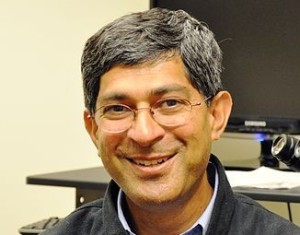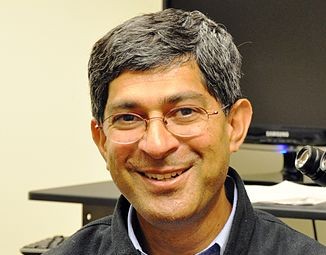 John Kuriyan, Senior Faculty Scientist in the Physical Biosciences Division and Chancellor’s Professor in the Departments of Molecular and Cell Biology and Chemistry at the University of California-Berkeley, gave the inaugural talk of the National Energy Research Super Computing (NERSC) Center’s Nobel Lunchtime Lecture Series.
John Kuriyan, Senior Faculty Scientist in the Physical Biosciences Division and Chancellor’s Professor in the Departments of Molecular and Cell Biology and Chemistry at the University of California-Berkeley, gave the inaugural talk of the National Energy Research Super Computing (NERSC) Center’s Nobel Lunchtime Lecture Series.
Kuriyan represented his graduate and post-doctoral mentor, Nobel laureate Martin Karplus. Karplus, along with Michael Levitt and Arieh Warshel, received the Nobel Prize in Chemistry for 2013 for the development of multiscale models for complex chemical systems. In announcing the 2013 Nobel laureates, the Royal Swedish Academy wrote, “Today the computer is just as important a tool for chemists as the test tube. Simulations are so realistic that they predict the outcome of traditional experiments.” Karplus has been using supercomputers at NERSC — the high-end scientific computing facility for the Department of Energy’s Office of Science — to support his research since 1998.
In his presentation, “Molecular Dynamics Simulations and the Mechanisms of Protein Complexes,” John Kuriyan used Karplus’ actual slides from his Nobel lecture in Stockholm to introduce the field of molecular dynamics and then gave his perspective as a structural biologist who uses these computational simulations to gain insight into the motions of biomolecules.
Kuriyan’s work includes the X-ray crystal structure of Abl kinase, which is specifically targeted by the drug, Gleevec, used in the treatment of chronic myelogenous leukemia (CML). Molecular dynamics simulations generated in collaboration with David E. Shaw of David E. Shaw Research and Columbia University depict the movement of the inhibitor as it searches for, and eventually finds, the active site.
The work of David Shaw is an example of the power computing plays in the evolution of molecular dynamics. Using Anton, a massively parallel supercomputer designed and built around customized integrated circuits, Shaw has been able to extend the timeframe of molecular dynamics simulations to the more biologically relevant millisecond timescale.
Kuriyan went on to share examples of simulations involving voltage-gated channels when the voltage is flipped, as well as molecular modeling of the replisome assembly at work replicating DNA. Molecular dynamics simulations performed on the sliding clamp at the heart of this machinery have provided insight into its interaction with other molecules in the assembly.
In Karplus’ final comments of his Nobel lecture, he expressed his wish that experimentalists would use these simulations as tools in their research. Kuriyan demonstrated the embodiment of this wish, using computational approaches to inform his research. While Karplus pointed out that like any other method, molecular dynamics simulations have limitations and inherent errors, Kuriyan showed the power of this integrated approach.
Watch this lecture on YouTube.




